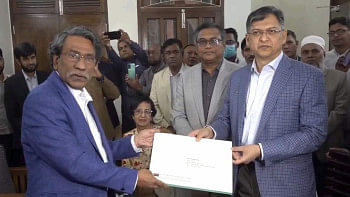Revisiting the National Poet's Life

On 29 August 1976, the national poet of Bangladesh Poet Kazi Nazrul Islam breathed his last in the Post Graduate hospital of Dhaka, Bangladesh. Professors Rafiqul Islam and Mustafa Zaman Abbasi reminded the authorities about his wish to be buried next to the mosque, when translated the song looks like this
Bury me near the mosque, O brother, place my grave there
So from below I may hear azaan, the sweet call to prayer
By my grave pious ones will pass, on their way to pray
I will hear their footsteps, while they make their way.
The sufferings of this sinner will be easier to bear
Following the Prophet, worshipping God, brimming with adulation
Faithful ones will fill the mosque, with Quranic recitation
Hearing the verses my heart will fill and soar high up there.
So many dervishes, fakirs, O brother, filled with spiritual light
Will chant Allah's name in the mosque, all day and all night
I want to join them and cry out, chanting His name in prayer
Chanting Allah's name in prayer.
Last week, I went to visit his graveyard, an eerie feeling came over me. I remembered the songs 'Dite ele phul he priyo ke aji shomadhite more? (Who is this loved one, visiting my grave, offering flowers?) And last lines, 'Shomadhi pashan nohe go tomar shoman kothor?' (Even the grave is not as stern as you!)
In life, poet Kazi Nazrul Islam faced many stone walls. Born in 1899, he lost his father at the tender age of eight. Facing dire economic consequences his schooling was erratic and often he had to fend for himself, working for odd jobs and paying his way through school. One kind gentleman picked him up from West Bengal, Mr Rafizuddin and admitted him to the Darirampur School in Trishal, Mymensingh. Nazrul studied one year and left for Searsol. There he studied in class eight and while in class nine, he and his close friend Shailajananda both took the entry test to join the army. Nazrul served in the army and started his writing in the barracks of Karachi (now Pakistan). He wrote his most famous piece 'The Bidrohi' poem in 1921, but he was taken to jail for another poem Anondomoyeer Agomone which when translated reads like this (excerpts only).
How much longer will you hide, woman,
Behind the statue of clay!
The cruel oppressing tyrants, over Heaven now hold sway.
They are whipping the child deities, hanging heroes so young,
India is a butcher house now,
O Destroyer, when will you come?
…….
With your sword, Mother, finish off their false adulation
Bring your sword and your arms, Mother, let us not be dead,
Make them into men, O Mother, we want to see bloodshed!
In1922, the poet married Parmila Nazrul. Earlier, he had an aborted relationship with Nargis of Comilla and it is in the same Comilla that the poet found Pramila. After their marriage, some good times were spent in Hoogly. Around these times, the poet wrote profusely and established himself as a poet. In 1928, he wrote his first ghazal styled song, and from then onwards until 1942, he rose to eminence with his songs, musical genius, poems, essays, journalistic work and political thoughts. He contracted a rare disease, a version of Alzheimer's termed Pig's diseases and lost all his faculties. We saw a poet without his faculties being received by Bangabandhu in Bangladesh in May 1972. Since then, he lived in Dhaka and breathed his last in August 1976.
He indeed came as a meteor and left the scene like one.
.................................................................
The writer is an academic, Nazrul exponent and writer.


 For all latest news, follow The Daily Star's Google News channel.
For all latest news, follow The Daily Star's Google News channel. 



Comments